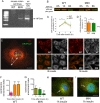Insulin signaling regulates a functional interaction between adenomatous polyposis coli and cytoplasmic dynein
- PMID: 28057765
- PMCID: PMC5328618
- DOI: 10.1091/mbc.E16-07-0555
Insulin signaling regulates a functional interaction between adenomatous polyposis coli and cytoplasmic dynein
Abstract
Diabetes is linked to an increased risk for colorectal cancer, but the mechanistic underpinnings of this clinically important effect are unclear. Here we describe an interaction between the microtubule motor cytoplasmic dynein, the adenomatous polyposis coli tumor suppressor protein (APC), and glycogen synthase kinase-3β (GSK-3β), which could shed light on this issue. GSK-3β is perhaps best known for glycogen regulation, being inhibited downstream in an insulin-signaling pathway. However, the kinase is also important in many other processes. Mutations in APC that disrupt the regulation of β-catenin by GSK-3β cause colorectal cancer in humans. Of interest, both APC and GSK-3β interact with microtubules and cellular membranes. We recently demonstrated that dynein is a GSK-3β substrate and that inhibition of GSK-3β promotes dynein-dependent transport. We now report that dynein stimulation in intestinal cells in response to acute insulin exposure (or GSK-3β inhibition) is blocked by tumor-promoting isoforms of APC that reduce an interaction between wild-type APC and dynein. We propose that under normal conditions, insulin decreases dynein binding to APC to stimulate minus end-directed transport, which could modulate endocytic and secretory systems in intestinal cells. Mutations in APC likely impair the ability to respond appropriately to insulin signaling. This is exciting because it has the potential to be a contributing factor in the development of colorectal cancer in patients with diabetes.
© 2017 Gao, Shi, et al. This article is distributed by The American Society for Cell Biology under license from the author(s). Two months after publication it is available to the public under an Attribution–Noncommercial–Share Alike 3.0 Unported Creative Commons License (http://creativecommons.org/licenses/by-nc-sa/3.0).
Figures








Similar articles
-
Human APC sequesters beta-catenin even in the absence of GSK-3beta in a Drosophila model.Oncogene. 2008 Apr 10;27(17):2488-93. doi: 10.1038/sj.onc.1210890. Epub 2007 Oct 29. Oncogene. 2008. PMID: 17968317
-
GSK-3β Phosphorylation of Cytoplasmic Dynein Reduces Ndel1 Binding to Intermediate Chains and Alters Dynein Motility.Traffic. 2015 Sep;16(9):941-61. doi: 10.1111/tra.12304. Epub 2015 Jun 26. Traffic. 2015. PMID: 26010407 Free PMC article.
-
GSK-3beta-dependent phosphorylation of adenomatous polyposis coli gene product can be modulated by beta-catenin and protein phosphatase 2A complexed with Axin.Oncogene. 2000 Jan 27;19(4):537-45. doi: 10.1038/sj.onc.1203359. Oncogene. 2000. PMID: 10698523
-
Adenomatous polyposis coli (Apc) tumor suppressor gene as a multifunctional gene.Anat Sci Int. 2005 Sep;80(3):121-31. doi: 10.1111/j.1447-073x.2005.00106.x. Anat Sci Int. 2005. PMID: 16158975 Review.
-
Calcium, calcium-sensing receptor and colon cancer.Cancer Lett. 2009 Mar 8;275(1):9-16. doi: 10.1016/j.canlet.2008.07.001. Epub 2008 Aug 23. Cancer Lett. 2009. PMID: 18725175 Review.
Cited by
-
Adenomatous Polyposis Coli (APC) in cell migration.Eur J Cell Biol. 2022 Jun-Aug;101(3):151228. doi: 10.1016/j.ejcb.2022.151228. Epub 2022 Apr 22. Eur J Cell Biol. 2022. PMID: 35483122 Free PMC article. Review.
-
APC controls Wnt-induced β-catenin destruction complex recruitment in human colonocytes.Sci Rep. 2020 Feb 19;10(1):2957. doi: 10.1038/s41598-020-59899-z. Sci Rep. 2020. PMID: 32076059 Free PMC article.
-
An Essential Postdevelopmental Role for Lis1 in Mice.eNeuro. 2018 Feb 2;5(1):ENEURO.0350-17.2018. doi: 10.1523/ENEURO.0350-17.2018. eCollection 2018 Jan-Feb. eNeuro. 2018. PMID: 29404402 Free PMC article.
-
Centrosomal enrichment and proteasomal degradation of SYS-1/β-catenin requires the microtubule motor dynein.Mol Biol Cell. 2022 May 1;33(5):ar42. doi: 10.1091/mbc.E22-02-0031. Epub 2022 Feb 23. Mol Biol Cell. 2022. PMID: 35196020 Free PMC article.
-
RAGE activation in macrophages and development of experimental diabetic polyneuropathy.JCI Insight. 2022 Dec 8;7(23):e160555. doi: 10.1172/jci.insight.160555. JCI Insight. 2022. PMID: 36477360 Free PMC article.
References
-
- Ait-Omar A, Monteiro-Sepulveda M, Poitou C, Le Gall M, Cotillard A, Gilet J, Garbin K, Houllier A, Chateau D, Lacombe A, et al. GLUT2 accumulation in enterocyte apical and intracellular membranes: a study in morbidly obese human subjects and ob/ob and high fat-fed mice. Diabetes. 2011;60:2598–2607. - PMC - PubMed
-
- Allan VJ. Cytoplasmic dynein. Biochem Soc Trans. 2011;39:1169–1178. - PubMed
-
- Andres SF, Santoro MA, Mah AT, Keku JA, Bortvedt AE, Blue RE, Lund PK. Deletion of intestinal epithelial insulin receptor attenuates high-fat diet-induced elevations in cholesterol and stem, enteroendocrine, and Paneth cell mRNAs. Am J Physiol Gastrointest Liver Physiol. 2015;308:G100–G111. - PMC - PubMed
MeSH terms
Substances
Grants and funding
LinkOut - more resources
Full Text Sources
Other Literature Sources
Medical
Molecular Biology Databases

